On this first day of spring I decided to walk through the property to see how our woodland native plants are faring so far this season.
I’m taking stock of which plants are thriving at the moment, and where, as I will need to collect seed, or take cuttings from some of these plants, to replant an area that was recently stripped almost bare.
Often garden plant losses in winter are due to weather, but in our case most of the losses this winter occurred last week due to some overzealous garden help.
I’m always reluctant to hire anyone to help manage the wilder areas of the property. Managing native plant areas requires knowledge not only of the plants, but the conditions in which they grow and thrive, and even I’m still learning about the natives that grow here. Fire prevention though mandates some degree of understory growth management, so this year as we’ve been so busy, we decided to bring in a little help.
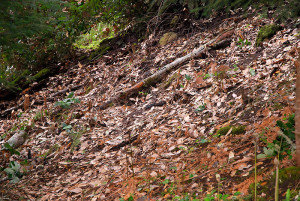
This slope faces east, and should be covered in redwood sorrel, with Trilliums, ferns and native gooseberries
That’s a decision I now regret, deeply. Despite being recommended to us, and being given strict instructions on what to remove, and what to leave alone, in one afternoon five years of carefully selectively weeding out the thugs, and encouraging the natives to repopulate the slope pictured above, was almost completely undone.
It’s clear that one person’s native plants, are simply another man’s weeds, and many of the native understory plants on that slope were torn from their roots a week ago, and disposed of with wild abandon. When I saw the end result, I didn’t know if I should scream, or cry.
Only now, a week later, can I write about it without my blood completely boiling over, but I keep telling myself, what’s done is done, and now I simply need to focus on formulating a plan for replanting this area near the house. It’s clear I’m going to need a lot of patience, and time…a lot of time both to replant the area, and time for the plants to grow.
Most of the plantings in this area consisted of native gooseberry (Ribes californicum), redwood sorrel, of which we have plenty elsewhere on the property, Trillium, Western Sword, Goldback, and Coastal Wood ferns, and a few prized Blue-bead Lilies (Clintonia andrewsiana).
I can easily over the next week or two divide some redwood sorrel, and transplant it, before our rainy season ends.
Sadly though, the Clintonia andrewsiana that was discovered on this slope two years ago, may be lost, and is more difficult, and significantly more expensive to replace. We’ll have to see if any appear from beneath the soil later in the spring.
A beautiful large native California Hazel (Corylus cornuta var. californica) is completely missing though, so I’m hoping I can replace it with some cuttings from this plant.
The hazel wasn’t alone. A number of young, relatively healthy Tanbark Oaks (Lithocarpus densiflorus) were cut down, which for me feels like a tremendous loss. Most of the mature oaks of this species here are far from healthy, so we’ve been thinning some of the canopy in the woodland, and trimming back the native California Bay Laurels (Umbellularia californica) that host the agent of sudden oak death (Phytophthora ramorum). We hoped that in time the young tanoaks would fill in to replace those that were dying.
Unfortunately, many of those replacements were cut down, and incinerated.
With much of the ground now cleared, my fear is that some of the more aggressive natives will fill in, like bracken fern, and try to completely take over before others can get re-established.
This would make replanting some of the other native species potentially more difficult, but as this area is much more exposed now, who knows, perhaps the shade from the brackens once they leaf out will at least help to get the redwood sorrel re-established. Can you tell I’m looking for a silver lining?
I’m also hoping that the woodland strawberries (Fragaria vesca) don’t smother the ground, as they tend to spread quickly in open areas here, and can quickly choke out other plants. The goats might be able to help here as strawberry leaves seem to be a favorite.
My greatest fear when I first saw the hillside though was that the Trillium ovatum growing here would all be gone.
Katie at Nature ID recently asked how our Trilliums were doing this season, as by many accounts it seems to have been a good year for Trillium ovatum in the Monterey Bay Area this season. I’d seen a few, but hadn’t really taken the time to see how many we had in bloom.
Each year we seem to gain a few more blooms, but Trillium take years to flower, and those not in bloom are often easy to overlook as they hide between other understory plants.
I’d say overall we do seem to have a few extra blooming this year, despite a few losses on this slope, and I think I must have found at least two dozen today on my walk down past the creek, including this one that isn’t quite open yet.
Although some are missing, or damaged, I’m hopeful that next spring many will regrow from their underground rhizomes on the slope.
Toward the creek I was surprised to already see our Milk Maids (Cardamine californica) in full bloom.
In this area they grow with a blanket of redwood sorrel at their feet, and scattered amidst the clover-like leaves of the sorrel, our Stream Violets are also blooming.
Our recent rains have recharged our drainage area, so water is actively flowing through the property at the moment, and more than eager to point out the hole I had in my right boot when I stepped in the channel to cross to the other side.
There were more Trillium in this area, and the first signs of the Western Sword Ferns preparing to push new fronds for spring.
As I hiked back toward the gardens, I found some Western Sweetgrass in bloom. I’m happy to see this, as unfortunately we lost quite a lot of this grass when we built the goat barn, and I’m eager to replant it.
I’m hoping this grass won’t be too difficult to start from seed. This is one of the few native grasses I can identify with any confidence, and it has such pretty blooms. I also found what appears to be some sort of Carex sp. Perhaps Carex globosa? If anyone has any identification tips, I’d welcome the input…I’m still not very good at identifying native grasses.
Nearby, our native Forget-Me-Nots (Cynoglossum grande) are thriving this year.
This is especially true inside the deer-fenced area where I found a half dozen plants all growing beneath a Ceanothus behind the greenhouse, one of which is already in bloom.
Nearby some native Western Wood Anemones are in bloom too,
right at the feet of the native Dogwoods (Cornus sericea ‘Isanti’) that are pushing new growth.
The snowberry (Symphoricarpos mollis and Symphoricarpos albus) are pushing lots of growth.
Lurking in between some snowberry though I also found the first sign of poison oak for the season too.
As much as we loathe poison oak, providing it’s not in the vegetable garden or orchard, we do try to leave it be as it’s an excellent habitat plant.
Scattered along the ground with the snowberry the Two-Eyed Violets are also in bloom.
In some of the more damp areas of the property, the Miner’s Lettuce is growing rampantly, but that’s no surprise.
I breathed a sigh of relief when I found the Spicebushes I planted last year are still with us and pushing growth. I’m really looking forward to seeing if they’ll bloom for us this year.
Also new to the garden, this Western Columbine (Aquilegia formosa) seems to be pushing lots of growth as well.
We’ve never grown one here, but are curious to see how it does in the garden, although I’m not sure if it will bloom this season.
Our native Big Leaf maples are showing their first signs of life this spring, and will soon be re-clothed in bright green leaves.
The stems of our native roses (Rosa gymnocarpa) are looking a little less menacing now that their leaves are emerging along their spiny stems.
The ‘Dark Star’ Ceanothus are blooming, although not profusely yet as these plants are quite young.
Our native Ceanothus, Ceanothus thyrsiflorus, should have a bumper crop of blooms this year though. This young plant is covered in buds from head to foot.
So overall, despite the relative devastation on the hillside at the beginning of this post, we have a lot of native plants blooming, and thriving elsewhere on the property that we can use to propagate new plants to revegetate the hillside. With the renewal that spring brings, and seeing so many of our native plants thriving, it’s difficult not to feel at least a little optimistic about how that slope may look again in a year or two. I just have to be patient.
In the meantime I’m going to be watching that slope like a hawk in the hopes the Clintonia will return. I can say, with confidence however, the overzealous gardener will not!

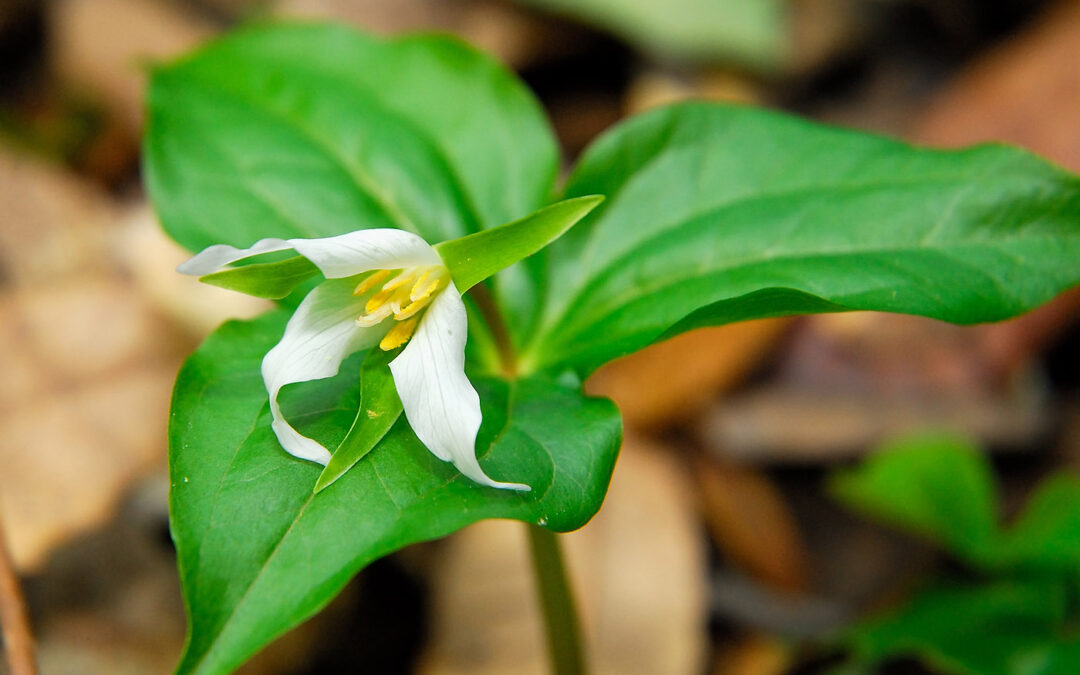
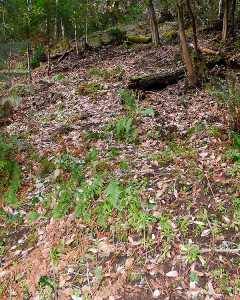
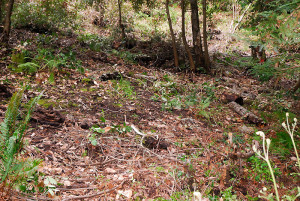
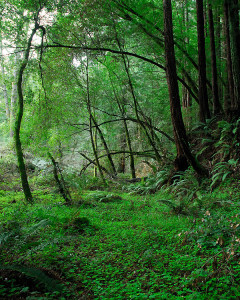
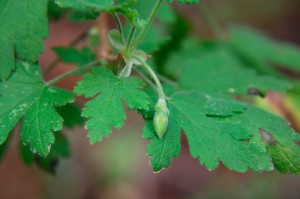
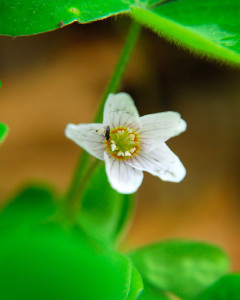
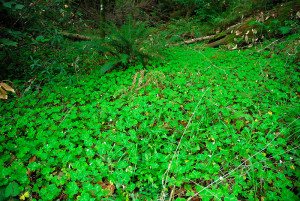
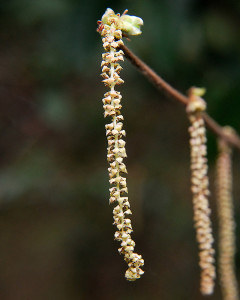

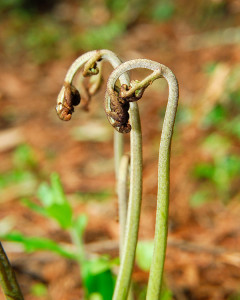
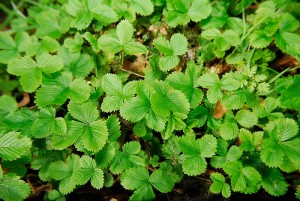
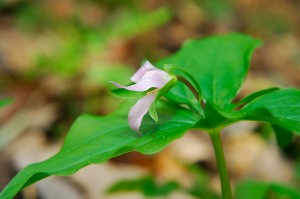


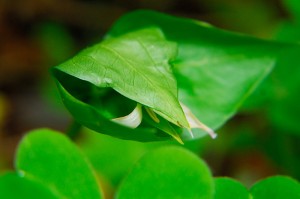
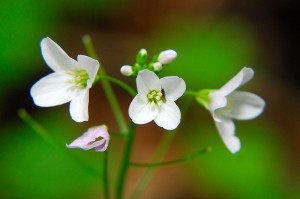
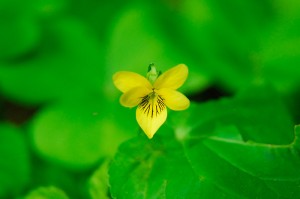
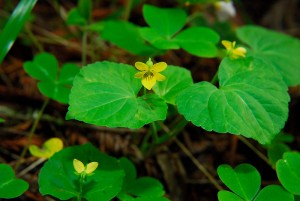
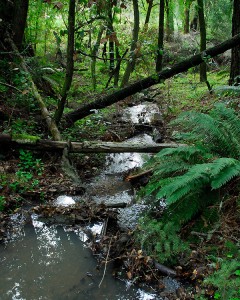
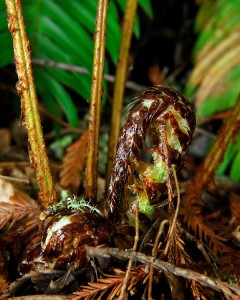
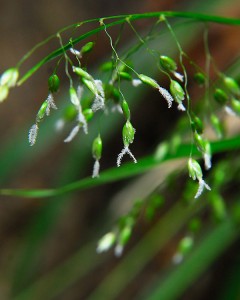
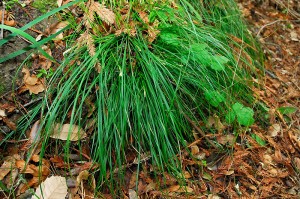
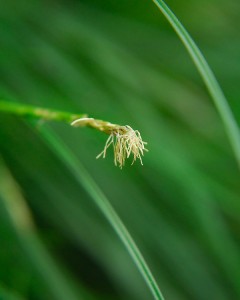
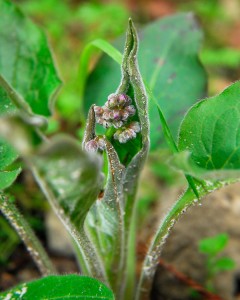
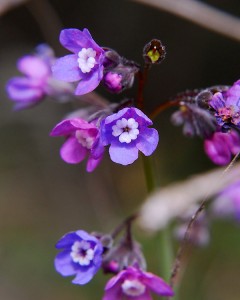

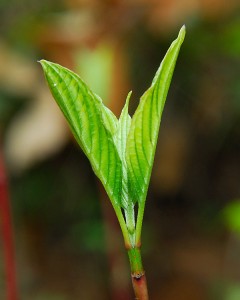
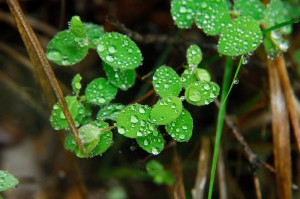

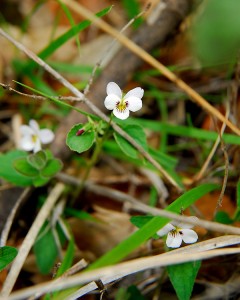
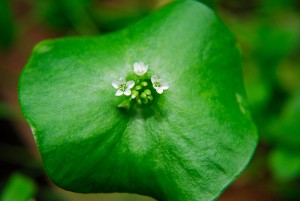
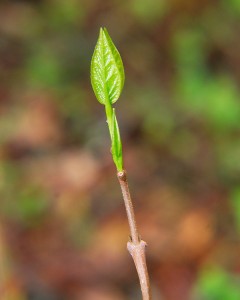
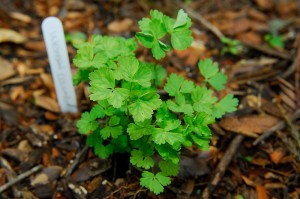
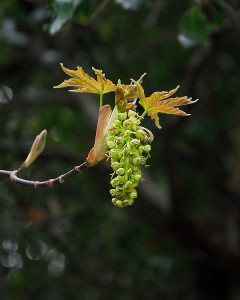
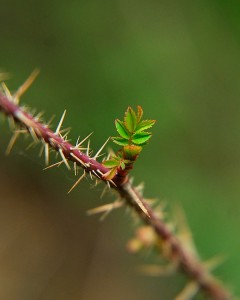
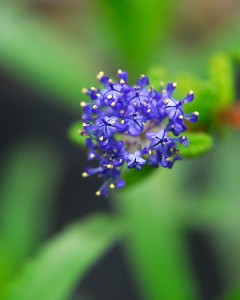

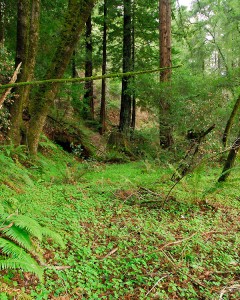







Lovely, lovely photos, Clare and you do live in such a pretty,woodsy spot. My hubby calls our stream a drainage area, but I don’t…it’s a seasonal stream to me. The trillium is especially dear,..you got such a great photo of it.
I would want to scream and cry, as well! But, I hope with faith in Nature that all your natives will come back…the seeds are there surely.
I prefer the sound of seasonal stream too. With two creeks on the property though, I tend to just call it the drainage, as it’s basically nature’s gutter that’s carved through mountain. It turns into quite a raging torrent though when the rains really come down!
I expect I may be surprised at what will volunteer on the slope…I just hope it’s not French Broom! 😯
Great shots! Hope they all thrive–except the Frageria;-)
Thanks Jan, I hope I can successfully divide and propagate some of these plants, I just have figure out which are best adapted to mostly morning sun for that slope 🙂
Clare,
Sad you found the wrong person to do this job, some things should be done personally I guess. I enjoyed seeing your Milk Maids (Cardamine californica) looks a lot like our Cutleaf Toothwarts.
How is the mite counts doing? Four powered sugar treatments and I’m down to 15 mites over 24 hours, before I did treatment it was 64 mites..
I love our Milk Maids. We only seem to see them down by the creek. I’m not why they don’t grow elsewhere. I know I’ve seen some around the county in much more sun than these gets, but it will be fun to try starting some from seed.
Our mites in Salvia are pretty high, but that hive is still a monster. We might try dusting too once we split her again, and that hive becomes more manageable. Still waiting to get back in to Rosemary though and see how well they did producing a new Queen, I just need the weather cooperate.
I would be really upset too. I hope that many of the plants return, maybe they left the roots behind? You have so much happening in your yard already!
Some plants like the ferns and Trillium have a good shot of coming back from the roots. I’m not about the Clintonia. Overall they seem difficult to grow. I’ll have to cross my fingers, and wait and see!
So sorry this happened. I once hired someone to help weed my garden. Never again. No matter how weedy my garden gets, I don’t trust anyone now! I hope your natives take back over, and that your clintonia is not lost. Nice to see that your trilliums are doing so well.
I feel the same, it’s difficult to trust anyone that’s not also a native plant gardener. I’d rather the garden looked a little ‘wild’ than go through this again.
Oh, that’s really hard to stomach. I swear 95% of the people who make their living as gardeners around here hate plants (as do a lot of the garden owners, so it often works out). I hope you’ll let the people who recommended your “help” know what happens, it’s important to get such information out.
Regardless, I’m glad things are looking so pretty and lush. Love the Trillium! Love the violets! Ah, it’s all stunning.
I told the people that recommended this gardener what happened. I certainly can’t fault his efficiency, he got more done in one afternoon than we accomplish in a whole weekend…I just wish he’d been a little less efficient. I am impressed with how much is growing and coming into bloom elsewhere though, we just have a little damage control to do between the barn building, and the scalped slope!
What a shame! Probably best to just convince yourself it was some act of Nature — like a lightning strike, hungry moose or two, or something similar — not an inept “helper”. (I’m quite worried that a late freeze will undo so much that the mild winter has primed me for.)
Beautiful shots though — plenty left to be excited about!
I tried that approach, and kept telling myself ‘at least it wasn’t a forest fire, then it would all be gone’.
I’ve been similarly concerned here about the weather too. The whole garden seemed convinced it was spring back in January, I’m just grateful we haven’t had any hard freezes (knock on wood).
I scream and weep with you.
But on a much smaller scale, our gardener weeded down to bare soil around the figs. Including my nasturtiums sob. Today I see a few seedlings poking thru.
Hope that five years work in your garden, will mean that some will sprout from the roots, and that the seed bank will claim its chance!
I hope your Nasturtiums come back Diana. I’m crossing my fingers we have a lot of potential beneath the soil that will resprout. In future though, I think I’ll do the weeding myself.
Oh Clare it must be heartbreaking and I really hope that Clintonia will emerge again and the hillside recovers from that heavy handed gardener. I think that little forget me not has such vivid colours in the petals and is so pretty.
I’m really hoping the Clintonia come back. I’ve seen them for sale, but very rarely, and they’re always expensive ($50+ for a 1 gallon plant). They’re not easy to get established, and the ones on this hillside haven’t multiplied at all in the last couple of years 🙁
Oh crumbs, that is horrid :/ I live in fear of our tenants trashing our garden in the next two years despite me practically leaving a manual for it… but similarly couldn’t bear to hire a gardener for fear they’d just cut it all down to the ground twice a year (as I’ve seen done in other properties).
It seems a lot of landscapers are insistent on either cutting plants to the ground, or pruning everything into the shape of a lollipop. I honestly can’t believe they’re paid to vandalize plants that way. Sometimes I think I chose the wrong profession 😛
Because you think you could prune a better lollipop that the pros? Just kidding!
Haha, no…I’d probably go for something different. Maybe try to prune it into the shape of an elephant or something 😛
Clare so sad this happened but hopefully things will return…I love your wildflowers…
We do have some lovely wildflowers popping up at the moment. I really can’t wait for the Iris to come up too…shouldn’t be long now!
I too am screaming, how could this happen?!?! Hoping you said something to the person hired. How will they learn if they aren’t told they’ve done wrong. Lucky you have so many spaces full of natives that can help replenish this area.
We decided we were primarily to blame, and that if we had this to do over again, this gardener clearly needed much more supervision than we thought.
The walk around the property though helped to put it all in perspective, and we’re fortunate that we do have a good native plant base to draw from on our own land for propagating. I think in this instance we’re just chalking it up to lesson learned.
Cutting down all those trees! So sad. I hope you can nurture the place back to life.
The trees were a bit much. Who just cuts down trees as part of routine brush clearance? I admit, that really surprised, and disappointed me!
How very sad. I know how devastated you must feel. But Mother Nature uses a continually changing palette. Some changes are wrought by nature herself, and can be better understood than changes brought about by an inept gardener. I feel your pain, but this too shall pass. I’m glad that you took such lovely photos of what remains. I hope those grasses, flowers and other remaining plants gladden your heart. Best wishes.
It will pass, and I’m sure Mother Nature will surprise me with her resilience and capacity to bounce back. I look forward to seeing what volunteers of its own accord 🙂
So nice to have found you. I am looking forward to watching a new year unfold in your garden!
Susan
Welcome Susan, thank you for dropping by. I’m looking forward to seeing what this season will bring too! 🙂
Why do I think you weren’t this temperate and philosophical when you initially saw the work of the gardener? If you can discuss this on a public blog, are you taking any action?
We had contractors rip off gigantic amounts of old growth redwood siding, when they worked on our foundation. This was done without our permission. And later they put a lien on our house, because we refused to pay for the replacement of the ruined siding. Good heavens! The audacity!
That’s why I waited a week to mention in it in a blog post. I was absolutely livid when I saw it, but I know that being angry won’t bring the plants back. At least I won’t run out of things to do this summer! First though, I need to order about 6 yards of soil for directly in front of the house. I have other planting to do!
Hate to say it, but it happens more than not. It is just easier for them to clear it than be selective. Many do know the difference, but it is making the job the easiest.
I see so many so-called ‘landscapers’ here that butcher trees, vandalize shrubs, and spray the living daylights out of gardens. It’s as if there’s only one way to maintain a garden, but I suppose some just want something pretty to look at, and not actually have to bother with it themselves. I’d rather have the dirt under my own nails 😉
Dear Clare, I am heartsick about this and it rings too true for me too. The Corylus, the…too much to consider. But, as you know full well, Mother Nature starts the healing process quickly.
Let us all know how the scarring is healed.
Spring blessings,
Sharon Lovejoy Writes from Sunflower House and a Little Green Island